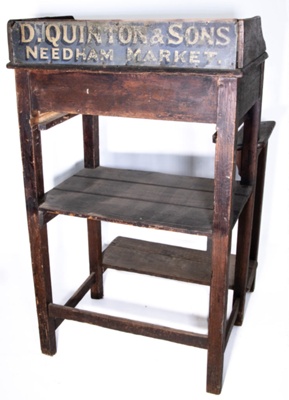Name/TitleCorn Merchant's Desk
About this objectUsed by D. Quinton & Sons in the Stowmarket Corn Exchange until it ceased to operate in December 1966. Quintons owned the corn mill (watermill) at Needham Market.
The top of the desk has a lockable 1 foot square lid. Below the desk compartment is a sliding tray which can be drawn out to project in front of the desk.
Research by Richard Hall, Volunteer:
Have you ever wondered how farmers used to sell their crops of wheat and barley? Millers and Maltsters used ‘Agents’ (no not the James Bond variety!), often knowledgeable employees, to buy grain at a ‘Corn Exchange’ (or open marketplace) for them to turn into flour for bread and baking or for malt for brewing. Rather than having a free for all, the farmer was able to go from one company to another in order to negotiate the best price for the crop.
Our wooden Corn Merchants Desks would be set up at a weekly market, held in a local Corn Exchange. From here the miller or maltster’s agent would negotiate the purchase of a crop with each farmer who visited his desk. There are two such desks in our collection, both used by different millers and in different corn exchanges.
This desk was owned by D. Quinton and Sons and used in the Stowmarket Corn Exchange. The representative stood on a 7’’ platform behind the desk which would have raised him above the farmers he traded with (probably a negotiating trick to obtain lower prices). The desk has a lockable lid and a seat for the representative to rest on. It has a shelf and a draw underneath the top. The drawer pulls out to the front of the desk. The drawers were used to store labelled up grain samples to return to the mill.
D. Quinton and Sons, were millers, corn merchants and animal food producers. They owned one of the two watermills in Needham Market, for which they would have bought grain via the Stowmarket Corn Exchange. Their mill was located on the B1078 Coddenham Road. It can still be seen today. This Grade Two listed watermill was built in the late 18th or early 19th Centuries. It is four storeys high with timber frame and weatherboard cladding. It is driven by a large ‘undershot’ (that is to say the water flowed underneath) water wheel. This type of arrangement was quite common in East Anglia, where the land is reasonably flat with little rise to aid water flow. An image of this mill, taken by Peter Dolman can be found on the Mills Archive website. Quinton’s continued to trade in Needham Market until 1991 when the company was bought out by Muntons.
In the 18th Century Corn Exchanges were held in an open market place but controlled by the local town or borough authorities, very much as open markets are today. Their popularity grew as demand for corn and wool increased and by the mid-18th Century richer boroughs considered erecting special ‘Corn Exchanges’ to allow trading to continue in all weathers. Also allowing the borough to charge a larger rent for each agent. Corn Exchanges’ were not limited specifically to trading in grains. The Bristol Corn Exchange, built in 1743, was also used to trade other produce, when grain was not being traded.
Several other towns and cities took the initiative and built their own Corn Exchanges to serve the surrounding area and growth in building accelerated following the repeal of the Corn Laws in 1846, which brought about a fall in corn prices due to cheap imports of grain from America. East Anglia, as a major agricultural economy, built Corn Exchanges in most market towns. In Essex there were six, Norfolk had eight and in Suffolk there were seven, found in; Beccles (1849), Bury St Edmunds (1862), Ipswich (1812), Hadleigh (1813), Haverhill (1889), Stowmarket (1835) and Sudbury (1841).
As we have already stated Corn Exchanges were not limited to trading grain, many served as community resources, hosting meetings, political meetings and other civic or social events such as concerts and dances. This was important to their survival as farming in the years between 1846 and 1946 was in depression and many people were forced to seek work in towns and cities.
Medium and MaterialsDeal
Inscription and MarksFront sign
D.QUINTON & SONS
NEEDHAM MARKET.
MeasurementsHeight: 125 cm
Length: 74 cm
Depth: 81 cm
Gallery: 5 inches
Shelf: 2 feet
Step at: 7 inches
Breadth: 2 feet 3 inches
Width: 1 foot 9 inches
Seat projection: 1 foot 4 inches
Seat width: 6 inches
Depth desk compartment: 5 inches
Lid: 1 foot square
Sliding tray: 1 inch below desk compartment
Sliding tray projection: 1 foot
Object numberSTMEA:A.985
Copyright Licence![]() Attribution - Non-commercial (cc)
Attribution - Non-commercial (cc)



